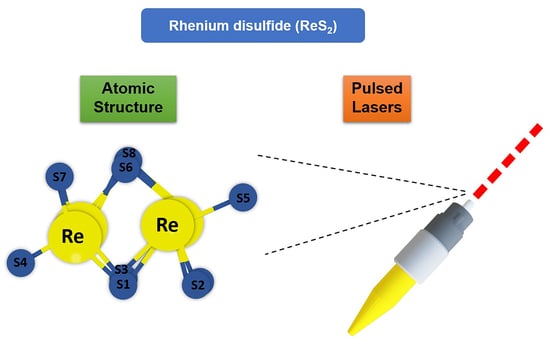A Review on Rhenium Disulfide: Synthesis Approaches, Optical Properties, and Applications in Pulsed Lasers
Abstract
:1. Introduction
2. Structure of ReS2 and Its Synthesis Methods
2.1. Rhenium Disulfide (ReS2)
2.2. Synthesis Techniques
2.2.1. Mechanical Exfoliation (ME)
2.2.2. Liquid Phase Exfoliation (LPE)
2.2.3. Physical Vapor Deposition (PVD)
2.2.4. Chemical Vapor Transport (CVT)
2.2.5. Chemical Vapor Deposition (CVD)
3. Photonic Applications
3.1. Saturable Absorbers
3.2. Nonlinear Absorption Characterization
3.3. Q-Switched Lasers
3.4. Mode-Locked Lasers
4. Discussion and Outlook
5. Conclusions
Author Contributions
Funding
Acknowledgments
Conflicts of Interest
References
- Keller, U. Recent developments in compact ultrafast lasers. Nature 2003, 424, 831–838. [Google Scholar] [CrossRef] [PubMed]
- Shi, W.; Fang, Q.; Zhu, X.; Norwood, R.A.; Peyghambarian, N. Fiber lasers and their applications. Appl. Opt. 2014, 53, 6554–6568. [Google Scholar] [CrossRef] [PubMed]
- Kobayashi, T. Development of ultrashort pulse lasers for ultrafast spectroscopy. Photonics 2018, 5, 19. [Google Scholar] [CrossRef] [Green Version]
- Morgenweg, J.; Barmes, I.; Eikema, K.S.E. Ramsey-comb spectroscopy with intense ultrashort laser pulses. Nat. Phys. 2014, 10, 30–33. [Google Scholar] [CrossRef] [Green Version]
- Udem, T.; Holzwarth, R.; Hänsch, T.W. Optical frequency metrology. Nature 2002, 416, 233–237. [Google Scholar] [CrossRef]
- Muhanad Fadhel, M.; Rashid, H.; Essa Hamzah, A.; Dzulkefly Zan, M.S.; Abd Aziz, N.; Arsad, N. Flat frequency comb generation employing cascaded single-drive Mach–Zehnder modulators with a simple analogue driving signal. J. Mod. Opt. 2021, 68, 536–541. [Google Scholar] [CrossRef]
- Elgaud, M.M.; Bakar, A.A.A.; Ghaith, A.A.; Naim, N.F.; Arsad, N.; Mokhtar, M.H.H.; Azeman, N.H.; Zan, M.S.D. Pulse Compressed Time Domain Multiplexed Fiber Bragg Grating Sensor: A Comparative Study. IEEE Access 2018, 6, 64427–64434. [Google Scholar] [CrossRef]
- Hamzah, A.E.; Zan, M.S.D.; Elgaud, M.; Fadhel, M.M.; Alwash, S.A.; Abushagur, A.A.; Mokhtar, M.H.H.; Azeman, N.H.; Ali, S.H.b.M.; Bakar, A.A.A. Signal Generation using System on Chip for Coded Fiber Bragg Grating Sensor. In Proceedings of the 2020 IEEE 8th International Conference on Photonics (ICP), Kota Bharu, Malaysia, 12 May–30 June 2020; pp. 80–81. [Google Scholar]
- Zan, M.S.D.; Elgaud, M.M.; Zainuddin, A.R.; Kadhim, A.S.; Mokhtar, M.H.H.; Arsad, N.; Bakar, A.A.A. Simulation Analysis on the Simultaneous Deployment of Brillouin Gain and Loss in Coded Brillouin Optical Time Domain Analysis (BOTDA) Fiber Sensor. J. Phys. Conf. Ser. 2021, 1892, 012034. [Google Scholar] [CrossRef]
- Liu, X.; Cui, Y.; Han, D.; Yao, X.; Sun, Z. Distributed ultrafast fibre laser. Sci. Rep. 2015, 5, 9101. [Google Scholar] [CrossRef] [PubMed] [Green Version]
- Taha, B.A.; Ali, N.; Sapiee, N.M.; Fadhel, M.M.; Mat Yeh, R.M.; Bachok, N.N.; Al Mashhadany, Y.; Arsad, N. Comprehensive Review Tapered Optical Fiber Configurations for Sensing Application: Trend and Challenges. Biosensors 2021, 11, 253. [Google Scholar] [CrossRef]
- Ippen, E.P. Principles of passive mode locking. Appl. Phys. B 1994, 58, 159–170. [Google Scholar] [CrossRef]
- Liu, J.; Wu, J.; Chen, H.; Chen, Y.; Wang, Z.; Ma, C.; Zhang, H. Short-pulsed Raman fiber laser and its dynamics. Sci. China Phys. Mech. 2020, 64, 214201. [Google Scholar] [CrossRef]
- Haus, H.A. Mode-locking of lasers. IEEE J. Sel. Top. Quantum Electron. 2000, 6, 1173–1185. [Google Scholar] [CrossRef]
- Xia, W.; Chen, X. Recent developments in fiber-based optical frequency comb and its applications. Meas. Sci. Technol. 2016, 27, 041001. [Google Scholar] [CrossRef] [Green Version]
- Woodward, R.I.; Kelleher, E.J. 2D saturable absorbers for fibre lasers. Appl. Sci. 2015, 5, 1440–1456. [Google Scholar] [CrossRef] [Green Version]
- Lu, F. Passively harmonic mode-locked fiber laser based on ReS2 saturable absorber. Mod. Phys. Lett. B 2017, 31, 1750206. [Google Scholar] [CrossRef]
- Soffer, B.H. Giant Pulse Laser Operation by a Passive, Reversibly Bleachable Absorber. J. Appl. Phys. 1964, 35, 2551. [Google Scholar] [CrossRef]
- Bret, G.; Gires, F. Giant-Pulse Laser and Light Amplifier Using Variable Transmission Coefficient Glasses as Light Switches. Appl. Phys. Lett. 1964, 4, 175–176. [Google Scholar] [CrossRef]
- Maiman, T.H. Stimulated Optical Radiation in Ruby. Nature 1960, 187, 493–494. [Google Scholar] [CrossRef]
- Ippen, E.P.; Shank, C.V.; Dienes, A. Passive mode locking of the cw dye laser. Appl. Phys. Lett. 1972, 21, 348–350. [Google Scholar] [CrossRef]
- Dzhibladze, M.I.; Ésiashvili, Z.G.; Teplitskiĭ, É.S.; Isaev, S.K.; Sagaradze, V.R. Mode locking in a fiber laser. Sov. J. Quantum Electron. 1983, 13, 245–247. [Google Scholar] [CrossRef]
- Keller, U.; Miller, D.; Boyd, G.; Chiu, T.; Ferguson, J.; Asom, M. Solid-state low-loss intracavity saturable absorber for Nd: YLF lasers: An antiresonant semiconductor Fabry–Perot saturable absorber. Opt. Lett. 1992, 17, 505–507. [Google Scholar] [CrossRef]
- Bogusławski, J.; Wang, Y.; Xue, H.; Yang, X.; Mao, D.; Gan, X.; Ren, Z.; Zhao, J.; Dai, Q.; Soboń, G.; et al. Graphene Actively Mode-Locked Lasers. Adv. Funct. Mater. 2018, 28, 1801539. [Google Scholar] [CrossRef]
- Wen, Q.-Y.; Tian, W.; Mao, Q.; Chen, Z.; Liu, W.-W.; Yang, Q.-H.; Sanderson, M.; Zhang, H.-W. Graphene based All-Optical Spatial Terahertz Modulator. Sci. Rep. 2014, 4, 7409. [Google Scholar] [CrossRef] [PubMed]
- Zhang, H.; Healy, N.; Shen, L.; Huang, C.C.; Hewak, D.W.; Peacock, A.C. Enhanced all-optical modulation in a graphene-coated fibre with low insertion loss. Sci. Rep. 2016, 6, 23512. [Google Scholar] [CrossRef] [Green Version]
- Cho, B.; Hahm, M.G.; Choi, M.; Yoon, J.; Kim, A.R.; Lee, Y.-J.; Park, S.-G.; Kwon, J.-D.; Kim, C.S.; Song, M.; et al. Charge-transfer-based Gas Sensing Using Atomic-layer MoS2. Sci. Rep. 2015, 5, 8052. [Google Scholar] [CrossRef]
- Wang, S.; Wang, J.; Zhao, W.; Giustiniano, F.; Chu, L.; Verzhbitskiy, I.; Zhou Yong, J.; Eda, G. Efficient Carrier-to-Exciton Conversion in Field Emission Tunnel Diodes Based on MIS-Type van der Waals Heterostack. Nano Lett. 2017, 17, 5156–5162. [Google Scholar] [CrossRef]
- Sun, X.; Qiu, C.; Wu, J.; Zhou, H.; Pan, T.; Mao, J.; Yin, X.; Liu, R.; Gao, W.; Fang, Z.; et al. Broadband photodetection in a microfiber-graphene device. Opt. Express 2015, 23, 25209–25216. [Google Scholar] [CrossRef] [PubMed]
- Martinez, A.; Sun, Z. Nanotube and graphene saturable absorbers for fibre lasers. Nat. Photonics 2013, 7, 842–845. [Google Scholar] [CrossRef]
- Hu, X.; Yasaei, P.; Jokisaari, J.; Öğüt, S.; Salehi-Khojin, A.; Klie, R.F. Mapping thermal expansion coefficients in freestanding 2D materials at the nanometer scale. Phys. Rev. Lett. 2018, 120, 055902. [Google Scholar] [CrossRef] [PubMed] [Green Version]
- Guerreiro, P.T.; Ten, S.; Borrelli, N.F.; Butty, J.; Jabbour, G.E.; Peyghambarian, N. PbS quantum-dot doped glasses as saturable absorbers for mode locking of a Cr:forsterite laser. Appl. Phys. Lett. 1997, 71, 1595–1597. [Google Scholar] [CrossRef]
- Set, S.Y.; Yaguchi, H.; Tanaka, Y.; Jablonski, M. Ultrafast fiber pulsed lasers incorporating carbon nanotubes. IEEE J. Sel. Top. Quantum Electron. 2004, 10, 137–146. [Google Scholar] [CrossRef]
- Bao, Q.; Zhang, H.; Wang, Y.; Ni, Z.; Yan, Y.; Shen, Z.X.; Loh, K.P.; Tang, D.Y. Atomic-layer graphene as a saturable absorber for ultrafast pulsed lasers. Adv. Funct. Mater. 2009, 19, 3077–3083. [Google Scholar] [CrossRef]
- Zhang, B.; Liu, J.; Wang, C.; Yang, K.; Lee, C.; Zhang, H.; He, J. Recent Progress in 2D Material-Based Saturable Absorbers for All Solid-State Pulsed Bulk Lasers. Laser Photonics Rev. 2020, 14, 1900240. [Google Scholar] [CrossRef]
- Novoselov, K.S.; Geim, A.K.; Morozov, S.V.; Jiang, D.; Zhang, Y.; Dubonos, S.V.; Grigorieva, I.V.; Firsov, A.A. Electric field effect in atomically thin carbon films. Science 2004, 306, 666–669. [Google Scholar] [CrossRef] [PubMed] [Green Version]
- Zhao, C.; Zhang, H.; Qi, X.; Chen, Y.; Wang, Z.; Wen, S.; Tang, D. Ultra-short pulse generation by a topological insulator based saturable absorber. Appl. Phys. Lett. 2012, 101, 211106. [Google Scholar] [CrossRef]
- Salim, M.A.M.; Ab Razak, M.Z.; Azzuhri, S.R.; Ismail, M.A. Generation of Microsecond Ytterbium-Doped Fibre Laser Pulses using Bismuth Telluride Thin Film as Saturable Absorber. Sains Malays. 2019, 48, 1289–1294. [Google Scholar] [CrossRef]
- Zhang, H.; Lu, S.; Zheng, J.; Du, J.; Wen, S.; Tang, D.; Loh, K. Molybdenum disulfide (MoS2) as a broadband saturable absorber for ultra-fast photonics. Opt. Express 2014, 22, 7249–7260. [Google Scholar] [CrossRef]
- Aizi Mat Salim, M.; Razalli Azzuhri, S.; Afiq Ismail, M.; Ab Razak, M.Z. Few Layer Molybdenum Selenide Saturable Absorber using Optical Deposition Technique for Q-switched Ytterbium Pulses Laser Generation. J. Phys. Conf. Ser. 2020, 1484, 012025. [Google Scholar] [CrossRef]
- Chen, Y.; Jiang, G.; Chen, S.; Guo, Z.; Yu, X.; Zhao, C.; Zhang, H.; Bao, Q.; Wen, S.; Tang, D. Mechanically exfoliated black phosphorus as a new saturable absorber for both Q-switching and mode-locking laser operation. Opt. Express 2015, 23, 12823–12833. [Google Scholar] [CrossRef] [Green Version]
- Sotor, J.; Sobon, G.; Macherzynski, W.; Paletko, P.; Abramski, K.M. Black phosphorus saturable absorber for ultrashort pulse generation. Appl. Phys. Lett. 2015, 107, 051108. [Google Scholar] [CrossRef] [Green Version]
- Jhon, Y.I.; Koo, J.; Anasori, B.; Seo, M.; Lee, J.H.; Gogotsi, Y.; Jhon, Y.M. Metallic MXene saturable absorber for femtosecond mode-locked lasers. Adv. Mater. 2017, 29, 1702496. [Google Scholar] [CrossRef] [PubMed]
- Song, Y.; Liang, Z.; Jiang, X.; Chen, Y.; Li, Z.; Lu, L.; Ge, Y.; Wang, K.; Zheng, J.; Lu, S.; et al. Few-layer antimonene decorated microfiber: Ultra-short pulse generation and all-optical thresholding with enhanced long term stability. 2D Mater. 2017, 4, 045010. [Google Scholar] [CrossRef]
- Hu, P.; Liu, Y.; Guo, L.; Ge, X.; Liu, X.; Yu, L.; Liu, Q. Passively Q-switched erbium-doped fiber laser based on antimonene as saturable absorber. Appl. Opt. 2019, 58, 7845–7850. [Google Scholar] [CrossRef]
- Lu, L.; Liang, Z.; Wu, L.; Chen, Y.; Song, Y.; Dhanabalan, S.C.; Ponraj, J.S.; Dong, B.; Xiang, Y.; Xing, F.; et al. Few-layer Bismuthene: Sonochemical Exfoliation, Nonlinear Optics and Applications for Ultrafast Photonics with Enhanced Stability. Laser Photonics Rev. 2018, 12, 1700221. [Google Scholar] [CrossRef]
- Chai, T.; Li, X.; Feng, T.; Guo, P.; Song, Y.; Chen, Y.; Zhang, H. Few-layer bismuthene for ultrashort pulse generation in a dissipative system based on an evanescent field. Nanoscale 2018, 10, 17617–17622. [Google Scholar] [CrossRef]
- Guo, B.; Wang, S.-H.; Wu, Z.-X.; Wang, Z.-X.; Wang, D.-H.; Huang, H.; Zhang, F.; Ge, Y.-Q.; Zhang, H. Sub-200 fs soliton mode-locked fiber laser based on bismuthene saturable absorber. Opt. Express 2018, 26, 22750–22760. [Google Scholar] [CrossRef]
- Ma, X.; Zhang, Z.; Jiang, W.; Tong, L.; Liu, S.; Dai, W.; Chen, W.; Zhou, Y.; Zhang, W.; Qiu, J.; et al. Passively mode-locked thulium doped fiber laser based on SnSe nanoparticles as a saturable absorber. Opt. Laser Technol. 2021, 138, 106870. [Google Scholar] [CrossRef]
- Chhowalla, M.; Shin, H.S.; Eda, G.; Li, L.-J.; Loh, K.P.; Zhang, H. The chemistry of two-dimensional layered transition metal dichalcogenide nanosheets. Nat. Chem. 2013, 5, 263–275. [Google Scholar] [CrossRef]
- Wilson, J.A.; Yoffe, A. The transition metal dichalcogenides discussion and interpretation of the observed optical, electrical and structural properties. Adv. Phys. 1969, 18, 193–335. [Google Scholar] [CrossRef]
- Li, X.; Chen, C.; Yang, Y.; Lei, Z.; Xu, H. 2D Re-Based Transition Metal Chalcogenides: Progress, Challenges, and Opportunities. Adv. Sci. 2020, 7, 2002320. [Google Scholar] [CrossRef]
- Rahman, M.; Davey, K.; Qiao, S.Z. Advent of 2D rhenium disulfide (ReS2): Fundamentals to applications. Adv. Funct. Mater. 2017, 27, 1606129. [Google Scholar] [CrossRef] [Green Version]
- Tongay, S.; Sahin, H.; Ko, C.; Luce, A.; Fan, W.; Liu, K.; Zhou, J.; Huang, Y.-S.; Ho, C.-H.; Yan, J.; et al. Monolayer behaviour in bulk ReS2 due to electronic and vibrational decoupling. Nat. Commun. 2014, 5, 3252. [Google Scholar] [CrossRef] [PubMed] [Green Version]
- Zhang, Q.; Fu, L. Novel Insights and Perspectives into Weakly Coupled ReS2 toward Emerging Applications. Chem 2019, 5, 505–525. [Google Scholar] [CrossRef] [Green Version]
- Zhang, E.; Jin, Y.; Yuan, X.; Wang, W.; Zhang, C.; Tang, L.; Liu, S.; Zhou, P.; Hu, W.; Xiu, F. ReS2-Based Field-Effect Transistors and Photodetectors. Adv. Funct. Mater. 2015, 25, 4076–4082. [Google Scholar] [CrossRef] [Green Version]
- Zulkefli, A.; Mukherjee, B.; Iwasaki, T.; Hayakawa, R.; Nakaharai, S.; Wakayama, Y. Gate-bias tunable humidity sensors based on rhenium disulfide field-effect transistors. Jpn. J. Appl. Phys. 2020, 60, SBBH01. [Google Scholar] [CrossRef]
- Hao, Q.; Wang, C.; Liu, W.; Liu, X.; Liu, J.; Zhang, H. Low-dimensional saturable absorbers for ultrafast photonics in solid-state bulk lasers: Status and prospects. Nanophotonics 2020, 9, 2603–2639. [Google Scholar] [CrossRef]
- Liu, X.; Gao, Q.; Zheng, Y.; Mao, D.; Zhao, J. Recent progress of pulsed fiber lasers based on transition-metal dichalcogenides and black phosphorus saturable absorbers. Nanophotonics 2020, 9, 2215–2231. [Google Scholar] [CrossRef] [Green Version]
- Cui, Y.; Lu, F.; Liu, X. Nonlinear Saturable and Polarization-induced Absorption of Rhenium Disulfide. Sci. Rep. 2017, 7, 40080. [Google Scholar] [CrossRef] [PubMed]
- Xu, X.; Jiang, M.; Li, D.; Wang, R.; Ren, Z.; Bai, J. Passive Q-switching based on ReS2 saturable absorber in Er-doped fiber laser at 1532 nm. Opt Quantum Electron 2018, 50, 39. [Google Scholar] [CrossRef]
- Su, X.; Nie, H.; Wang, Y.; Li, G.; Yan, B.; Zhang, B.; Yang, K.; He, J. Few-layered ReS2 as saturable absorber for 2.8 μm solid state laser. Opt. Lett. 2017, 42, 3502–3505. [Google Scholar] [CrossRef] [PubMed]
- Mao, D.; Cui, X.; Gan, X.; Li, M.; Zhang, W.; Lu, H.; Zhao, J. Passively Q-Switched and Mode-Locked Fiber Laser Based on an ReS2 Saturable Absorber. IEEE J. Sel. Top. Quantum Electron. 2018, 24, 1–6. [Google Scholar] [CrossRef]
- He, J.; Zeng, G.; Liu, S.; Lu, H.; Xie, R.; Qi, J.; Tao, L.; Zhou, B. Preparation of ultrathin ReS2 nanosheets and their application to Q-switched Er-doped fiber lasers. Front. Inf. Technol. Electron. Eng. 2021, 22, 296–302. [Google Scholar] [CrossRef]
- Zhao, R.; Li, G.; Zhang, B.; He, J. Multi-wavelength bright-dark pulse pair fiber laser based on rhenium disulfide. Opt. Express 2018, 26, 5819–5826. [Google Scholar] [CrossRef]
- Zhang, M.; Yin, J.; Yan, P. Two-dimensional ReS2 nanosheets based saturable absorbers for passively mode-locked fiber lasers. In Proceedings of the CLEO Pacific Rim Conference 2018, Hong Kong, 29 July 2018; p. W3A.151. [Google Scholar]
- Xu, X.; He, M.; Quan, C.; Wang, R.; Liu, C.; Zhao, Q.; Zhou, Y.; Bai, J.; Xu, X. Saturable Absorption Properties of ReS2 Films and Mode-Locking Application Based on Double-Covered ReS2 Micro Fiber. J. Light. Technol. 2018, 36, 5130–5136. [Google Scholar] [CrossRef]
- Zuo, C.; Cao, Y.; Yang, Q.; He, J.; Zhang, B. Passively Q-switched 2.95-μm bulk laser based on rhenium disulfide as saturable absorber. IEEE Photon. Technol. Lett. 2019, 31, 206–209. [Google Scholar] [CrossRef]
- Liu, S.; Wang, M.; Yin, S.; Xie, Z.; Wang, Z.; Zhou, S.; Chen, P. Nonlinear Optical Properties of Few-Layer Rhenium Disulfide Nanosheets and Their Passively Q-switched Laser Application. Phys. Status Solidi A 2019, 216, 1800837. [Google Scholar] [CrossRef]
- Lin, M.; Peng, Q.; Hou, W.; Fan, X.; Liu, J. 1.3 μm Q-switched solid-state laser based on few-layer ReS2 saturable absorber. Opt. Laser Technol. 2019, 109, 90–93. [Google Scholar] [CrossRef]
- Han, S.; Zhou, S.; Liu, X.; Liu, Y.; Zhang, S.; Yang, X. Rhenium disulfide-based passively Q-switched dual-wavelength laser at 0.95 μm and 1.06 μm in Nd:YAG. Laser Phys. Lett. 2018, 15, 085804. [Google Scholar] [CrossRef]
- Noddack, W. Die ekamangane. Naturwissenschaften 1925, 13, 567. [Google Scholar]
- Lin, Y.-C.; Komsa, H.-P.; Yeh, C.-H.; Bjorkman, T.; Liang, Z.-Y.; Ho, C.-H.; Huang, Y.-S.; Chiu, P.-W.; Krasheninnikov, A.V.; Suenaga, K. Single-layer ReS2: Two-dimensional semiconductor with tunable in-plane anisotropy. ACS Nano 2015, 9, 11249–11257. [Google Scholar] [CrossRef] [PubMed]
- Liu, E.; Fu, Y.; Wang, Y.; Feng, Y.; Liu, H.; Wan, X.; Zhou, W.; Wang, B.; Shao, L.; Ho, C.-H.; et al. Integrated digital inverters based on two-dimensional anisotropic ReS2 field-effect transistors. Nat. Commun. 2015, 6, 6991. [Google Scholar] [CrossRef]
- Yun, W.S.; Han, S.; Hong, S.C.; Kim, I.G.; Lee, J. Thickness and strain effects on electronic structures of transition metal dichalcogenides: 2H-M X 2 semiconductors (M = Mo, W; X = S, Se, Te). Phys. Rev. B 2012, 85, 033305. [Google Scholar] [CrossRef]
- Zhang, H.; Li, X.-B.; Liu, L.-M. Tunable electronic and magnetic properties of WS2 nanoribbons. J. Appl. Phys. 2013, 114, 093710. [Google Scholar] [CrossRef] [Green Version]
- Ho, C.; Huang, Y.; Tiong, K.; Liao, P. In-plane anisotropy of the optical and electrical properties of layered ReS2 crystals. J. Phys. Condens. Matter 1999, 11, 5367. [Google Scholar] [CrossRef]
- Mohamed, N.B.; Shinokita, K.; Wang, X.; Lim, H.E.; Tan, D.; Miyauchi, Y.; Matsuda, K. Photoluminescence quantum yields for atomically thin-layered ReS2: Identification of indirect-bandgap semiconductors. Appl. Phys. Lett. 2018, 113, 121112. [Google Scholar] [CrossRef]
- Chenet, D.A.; Aslan, O.B.; Huang, P.Y.; Fan, C.; van der Zande, A.M.; Heinz, T.F.; Hone, J.C. In-Plane Anisotropy in Mono- and Few-Layer ReS2 Probed by Raman Spectroscopy and Scanning Transmission Electron Microscopy. Nano Lett. 2015, 15, 5667–5672. [Google Scholar] [CrossRef]
- Feng, Y.; Zhou, W.; Wang, Y.; Zhou, J.; Liu, E.; Fu, Y.; Ni, Z.; Wu, X.; Yuan, H.; Miao, F.; et al. Raman vibrational spectra of bulk to monolayer ReS2 with lower symmetry. Phys. Rev. B 2015, 92, 054110. [Google Scholar] [CrossRef] [Green Version]
- Nagler, P.; Plechinger, G.; Schüller, C.; Korn, T. Observation of anisotropic interlayer Raman modes in few-layer ReS2. Phys. Status Solidi RRL 2016, 10, 185–189. [Google Scholar] [CrossRef] [Green Version]
- Lee, C.; Yan, H.; Brus, L.E.; Heinz, T.F.; Hone, J.; Ryu, S. Anomalous Lattice Vibrations of Single- and Few-Layer MoS2. ACS Nano 2010, 4, 2695–2700. [Google Scholar] [CrossRef] [Green Version]
- Lee, C.; Wei, X.; Kysar, J.W.; Hone, J. Measurement of the elastic properties and intrinsic strength of monolayer graphene. Science 2008, 321, 385–388. [Google Scholar] [CrossRef]
- Bertolazzi, S.; Brivio, J.; Kis, A. Stretching and Breaking of Ultrathin MoS2. ACS Nano 2011, 5, 9703–9709. [Google Scholar] [CrossRef]
- Novoselov, K.S.; Geim, A.K.; Morozov, S.V.; Jiang, D.; Katsnelson, M.I.; Grigorieva, I.V.; Dubonos, S.V.; Firsov, A.A. Two-dimensional gas of massless Dirac fermions in graphene. Nature 2005, 438, 197–200. [Google Scholar] [CrossRef]
- Zhang, Y.; Tan, Y.-W.; Stormer, H.L.; Kim, P. Experimental observation of the quantum Hall effect and Berry’s phase in graphene. Nature 2005, 438, 201–204. [Google Scholar] [CrossRef] [PubMed] [Green Version]
- Liu, E.; Long, M.; Zeng, J.; Luo, W.; Wang, Y.; Pan, Y.; Zhou, W.; Wang, B.; Hu, W.; Ni, Z. High responsivity phototransistors based on few-layer ReS2 for weak signal detection. Adv. Funct. Mater. 2016, 26, 1938–1944. [Google Scholar] [CrossRef] [Green Version]
- Lorchat, E.; Froehlicher, G.; Berciaud, S. Splitting of Interlayer Shear Modes and Photon Energy Dependent Anisotropic Raman Response in N-Layer ReSe2 and ReS2. ACS Nano 2016, 10, 2752–2760. [Google Scholar] [CrossRef] [Green Version]
- Xiong, Y.; Chen, H.; Zhang, D.W.; Zhou, P. Electronic and optoelectronic applications based on ReS2. Phys. Status Solidi—Rapid Res. Lett. 2019, 13, 1800658. [Google Scholar] [CrossRef]
- Kang, J.; Sangwan, V.K.; Wood, J.D.; Liu, X.; Balla, I.; Lam, D.; Hersam, M.C. Layer-by-Layer Sorting of Rhenium Disulfide via High-Density Isopycnic Density Gradient Ultracentrifugation. Nano Lett. 2016, 16, 7216–7223. [Google Scholar] [CrossRef]
- Xu, X.; Guo, Y.; Zhao, Q.; Si, K.; Zhou, Y.; Ma, J.; Bai, J.; Xu, X. Green and efficient exfoliation of ReS2 and its photoelectric response based on electrophoretic deposited photoelectrodes. Mater. Des. 2018, 159, 11–19. [Google Scholar] [CrossRef]
- Miao, Z.H.; Lv, L.X.; Li, K.; Liu, P.Y.; Li, Z.; Yang, H.; Zhao, Q.; Chang, M.; Zhen, L.; Xu, C.Y. Liquid exfoliation of colloidal rhenium disulfide nanosheets as a multifunctional theranostic agent for in vivo photoacoustic/ct imaging and photothermal therapy. Small 2018, 14, 1703789. [Google Scholar] [CrossRef]
- Fujita, T.; Ito, Y.; Tan, Y.; Yamaguchi, H.; Hojo, D.; Hirata, A.; Voiry, D.; Chhowalla, M.; Chen, M. Chemically exfoliated ReS2 nanosheets. Nanoscale 2014, 6, 12458–12462. [Google Scholar] [CrossRef] [PubMed]
- Wu, S.; Huang, C.; Aivazian, G.; Ross, J.S.; Cobden, D.H.; Xu, X. Vapor–solid growth of high optical quality MoS2 monolayers with near-unity valley polarization. ACS Nano 2013, 7, 2768–2772. [Google Scholar] [CrossRef] [Green Version]
- Feng, Q.; Zhu, Y.; Hong, J.; Zhang, M.; Duan, W.; Mao, N.; Wu, J.; Xu, H.; Dong, F.; Lin, F.; et al. Growth of Large-Area 2D MoS2(1-x)Se2x Semiconductor Alloys. Adv. Mater. 2014, 26, 2648–2653. [Google Scholar] [CrossRef] [PubMed]
- Qi, F.; Chen, Y.; Zheng, B.; Zhou, J.; Wang, X.; Li, P.; Zhang, W. Facile growth of large-area and high-quality few-layer ReS2 by physical vapour deposition. Mater. Lett. 2016, 184, 324–327. [Google Scholar] [CrossRef]
- Wang, D.; Luo, F.; Lu, M.; Xie, X.; Huang, L.; Huang, W. Chemical Vapor Transport Reactions for Synthesizing Layered Materials and Their 2D Counterparts. Small 2019, 15, 1804404. [Google Scholar] [CrossRef]
- Jariwala, B.; Voiry, D.; Jindal, A.; Chalke, B.A.; Bapat, R.; Thamizhavel, A.; Chhowalla, M.; Deshmukh, M.; Bhattacharya, A. Synthesis and Characterization of ReS2 and ReSe2 Layered Chalcogenide Single Crystals. Chem. Mater. 2016, 28, 3352–3359. [Google Scholar] [CrossRef]
- Xing, L.; Yan, X.; Zheng, J.; Xu, G.; Lu, Z.; Liu, L.; Wang, J.; Wang, P.; Pan, X.; Jiao, L. Highly crystalline ReSe2 atomic layers synthesized by chemical vapor transport. InfoMat 2019, 1, 552–558. [Google Scholar] [CrossRef] [Green Version]
- Zhou, X.; Gan, L.; Tian, W.; Zhang, Q.; Jin, S.; Li, H.; Bando, Y.; Golberg, D.; Zhai, T. Ultrathin SnSe2 Flakes Grown by Chemical Vapor Deposition for High-Performance Photodetectors. Adv. Mater. 2015, 27, 8035–8041. [Google Scholar] [CrossRef]
- Lee, Y.-H.; Zhang, X.-Q.; Zhang, W.; Chang, M.-T.; Lin, C.-T.; Chang, K.-D.; Yu, Y.-C.; Wang, J.T.-W.; Chang, C.-S.; Li, L.-J.; et al. Synthesis of Large-Area MoS2 Atomic Layers with Chemical Vapor Deposition. Adv. Mater. 2012, 24, 2320–2325. [Google Scholar] [CrossRef] [PubMed] [Green Version]
- Keyshar, K.; Gong, Y.; Ye, G.; Brunetto, G.; Zhou, W.; Cole, D.P.; Hackenberg, K.; He, Y.; Machado, L.; Kabbani, M. Chemical vapor deposition of monolayer rhenium disulfide (ReS2). Adv. Mater. 2015, 27, 4640–4648. [Google Scholar] [CrossRef] [PubMed]
- Hafeez, M.; Gan, L.; Li, H.; Ma, Y.; Zhai, T. Large-area bilayer ReS2 film/multilayer ReS2 flakes synthesized by chemical vapor deposition for high performance photodetectors. Adv. Funct. Mater. 2016, 26, 4551–4560. [Google Scholar] [CrossRef]
- Dathbun, A.; Kim, Y.; Kim, S.; Yoo, Y.; Kang, M.S.; Lee, C.; Cho, J.H. Large-Area CVD-Grown Sub-2 V ReS2 Transistors and Logic Gates. Nano Lett. 2017, 17, 2999–3005. [Google Scholar] [CrossRef]
- Yin, J.; Li, J.; Chen, H.; Wang, J.; Yan, P.; Liu, M.; Liu, W.; Lu, W.; Xu, Z.; Zhang, W.; et al. Large-area highly crystalline WSe2 atomic layers for ultrafast pulsed lasers. Opt. Express 2017, 25, 30020–30031. [Google Scholar] [CrossRef]
- Wang, G.; Baker-Murray, A.A.; Blau, W.J. Saturable Absorption in 2D Nanomaterials and Related Photonic Devices. Laser Photonics Rev. 2019, 13, 1800282. [Google Scholar] [CrossRef]
- Liu, W.; Liu, M.; Liu, X.; Wang, X.; Deng, H.X.; Lei, M.; Wei, Z.; Wei, Z. Recent advances of 2D materials in nonlinear photonics and fiber lasers. Adv. Opt. Mater. 2020, 8, 1901631. [Google Scholar] [CrossRef]
- Du, J.; Wang, Q.; Jiang, G.; Xu, C.; Zhao, C.; Xiang, Y.; Chen, Y.; Wen, S.; Zhang, H. Ytterbium-doped fiber laser passively mode locked by few-layer Molybdenum Disulfide (MoS2) saturable absorber functioned with evanescent field interaction. Sci. Rep. 2014, 4, 6346. [Google Scholar] [CrossRef] [PubMed]
- Song, Y.-W.; Yamashita, S.; Maruyama, S. Single-walled carbon nanotubes for high-energy optical pulse formation. Appl. Phys. Lett. 2008, 92, 021115. [Google Scholar] [CrossRef]
- Ge, Y.; Zhu, Z.; Xu, Y.; Chen, Y.; Chen, S.; Liang, Z.; Song, Y.; Zou, Y.; Zeng, H.; Xu, S.; et al. Broadband Nonlinear Photoresponse of 2D TiS2 for Ultrashort Pulse Generation and All-Optical Thresholding Devices. Adv. Opt. Mater. 2018, 6, 1701166. [Google Scholar] [CrossRef]
- Khazaeinezhad, R.; Hosseinzadeh Kassani, S.; Nazari, T.; Jeong, H.; Kim, J.; Choi, K.; Lee, J.-U.; Kim, J.H.; Cheong, H.; Yeom, D.-I.; et al. Saturable optical absorption in MoS2 nano-sheet optically deposited on the optical fiber facet. Opt. Commun. 2015, 335, 224–230. [Google Scholar] [CrossRef]
- Ahmad, H.; Muhammad, F.D.; Zulkifli, M.Z.; Harun, S.W. Graphene-Oxide-Based Saturable Absorber for All-Fiber Q-Switching with a Simple Optical Deposition Technique. IEEE Photonics J. 2012, 4, 2205–2213. [Google Scholar] [CrossRef]
- Jin, X.; Hu, G.; Zhang, M.; Hu, Y.; Albrow-Owen, T.; Howe, R.C.; Wu, T.-C.; Wu, Q.; Zheng, Z.; Hasan, T. 102 fs pulse generation from a long-term stable, inkjet-printed black phosphorus-mode-locked fiber laser. Opt. Express 2018, 26, 12506–12513. [Google Scholar] [CrossRef]
- Zhang, M.; Wu, Q.; Zhang, F.; Chen, L.; Jin, X.; Hu, Y.; Zheng, Z.; Zhang, H. 2D Black Phosphorus Saturable Absorbers for Ultrafast Photonics. Adv. Opt. Mater. 2019, 7, 1800224. [Google Scholar] [CrossRef] [Green Version]
- Mao, D.; Li, M.; Cui, X.; Zhang, W.; Lu, H.; Song, K.; Zhao, J. Stable high-power saturable absorber based on polymer-black-phosphorus films. Opt. Commun. 2018, 406, 254–259. [Google Scholar] [CrossRef]
- Sheik-Bahae, M.; Said, A.A.; Wei, T.; Hagan, D.J.; Stryland, E.W.V. Sensitive measurement of optical nonlinearities using a single beam. IEEE J. Quantum Electron. 1990, 26, 760–769. [Google Scholar] [CrossRef] [Green Version]
- Woodward, R.; Howe, R.; Hu, G.; Torrisi, F.; Zhang, M.; Hasan, T.; Kelleher, E. Few-layer MoS2 saturable absorbers for short-pulse laser technology: Current status and future perspectives. Photonics Res. 2015, 3, A30–A42. [Google Scholar] [CrossRef]
- Jeon, J.; Lee, J.; Lee, J.H. Numerical study on the minimum modulation depth of a saturable absorber for stable fiber laser mode locking. JOSA B 2015, 32, 31–37. [Google Scholar] [CrossRef]
- Haiml, M.; Grange, R.; Keller, U. Optical characterization of semiconductor saturable absorbers. Appl. Phys. B 2004, 79, 331–339. [Google Scholar] [CrossRef] [Green Version]
- Zhang, Y.; Lu, D.; Yu, H.; Zhang, H. Low-Dimensional Saturable Absorbers in the Visible Spectral Region. Adv. Opt. Mater. 2019, 7, 1800886. [Google Scholar] [CrossRef] [Green Version]
- Du, J.; Zhang, M.; Guo, Z.; Chen, J.; Zhu, X.; Hu, G.; Peng, P.; Zheng, Z.; Zhang, H. Phosphorene quantum dot saturable absorbers for ultrafast fiber lasers. Sci. Rep. 2017, 7, 42357. [Google Scholar] [CrossRef] [Green Version]
- Guo, B. 2D noncarbon materials-based nonlinear optical devices for ultrafast photonics. Chin. Opt. Lett. 2018, 16, 020004. [Google Scholar] [CrossRef]
- Su, X.; Zhang, B.; Wang, Y.; He, G.; Li, G.; Lin, N.; Yang, K.; He, J.; Liu, S. Broadband rhenium disulfide optical modulator for solid-state lasers. Photonics Res. 2018, 6, 498–505. [Google Scholar] [CrossRef] [Green Version]
- Zhang, N.; Zeng, Z.; Wang, Z.; Li, B.; Pan, Y. Nd:YSAG Q-switched laser with anisotropic ReS2 nanosheets. Optik 2020, 208, 164542. [Google Scholar] [CrossRef]
- Fan, M.; Li, T.; Zhao, J.; Zhao, S.; Li, G.; Yang, K.; Su, L.; Ma, H.; Kränkel, C. Continuous wave and ReS2 passively Q-switched Er : SrF2 laser at ∼3 μm. Opt. Lett. 2018, 43, 1726–1729. [Google Scholar] [CrossRef] [PubMed]
- Lu, B.; Wen, Z.; Huang, K.; Qi, X.; Wang, N.; Chen, H.; Bai, J. Passively Q-Switched Yb3+-Doped Fiber Laser With ReS2 Saturable Absorber. IEEE J. Sel. Top. Quantum Electron. 2019, 25, 1–4. [Google Scholar] [CrossRef]
- Zhang, S.; Ma, Y.; Liu, X.; Ding, S.; Yu, X.; Zhang, Q. Continuous wave and rhenium disulfide passively Q-switched Nd:GdLaNbO4 laser under direct pumping. Opt. Commun. 2020, 473, 125977. [Google Scholar] [CrossRef]
- Zhou, Y.; Fang, C.; Zhang, Z.; Tong, L.; Ma, X.; Zhang, W.; Yu, R.; Gao, W.; Xu, J.; Liao, M.; et al. Sub-picosecond passively mode-locked thulium-doped fiber laser by ReS2 nanoparticles. Jpn. J. Appl. Phys. 2020, 60, 011001. [Google Scholar] [CrossRef]
- Steinberg, D.; Zapata, J.D.; Souza, E.A.T.d.; Saito, L.A.M. Mechanically exfoliated Rhenium disulfide onto D-shaped optical fiber for sub-300 fs EDFL mode-locking. In Proceedings of the 2018 Conference on Lasers and Electro-Optics (CLEO), San Jose, CA, USA, 13–18 May 2018; pp. 1–2. [Google Scholar]
- Cui, Q.; He, J.; Bellus, M.Z.; Mirzokarimov, M.; Hofmann, T.; Chiu, H.Y.; Antonik, M.; He, D.; Wang, Y.; Zhao, H. Transient absorption measurements on anisotropic monolayer ReS2. Small 2015, 11, 5565–5571. [Google Scholar] [CrossRef]
- Trushin, M.; Kelleher, E.J.R.; Hasan, T. Theory of edge-state optical absorption in two-dimensional transition metal dichalcogenide flakes. Phys. Rev. B 2016, 94, 155301. [Google Scholar] [CrossRef] [Green Version]
- Mao, D.; Zhang, S.; Wang, Y.; Gan, X.; Zhang, W.; Mei, T.; Wang, Y.; Wang, Y.; Zeng, H.; Zhao, J. WS2 saturable absorber for dissipative soliton mode locking at 1.06 and 1.55 µm. Opt. Express 2015, 23, 27509–27519. [Google Scholar] [CrossRef] [PubMed]
- Wang, S.; Yu, H.; Zhang, H.; Wang, A.; Zhao, M.; Chen, Y.; Mei, L.; Wang, J. Broadband few-layer MoS2 saturable absorbers. Adv. Mater. 2014, 26, 3538–3544. [Google Scholar] [CrossRef] [PubMed]
- Woodward, R.I.; Kelleher, E.J.R.; Howe, R.C.T.; Hu, G.; Torrisi, F.; Hasan, T.; Popov, S.V.; Taylor, J.R. Tunable Q-switched fiber laser based on saturable edge-state absorption in few-layer molybdenum disulfide (MoS2). Opt. Express 2014, 22, 31113–31122. [Google Scholar] [CrossRef]
- Wang, K.; Feng, Y.; Chang, C.; Zhan, J.; Wang, C.; Zhao, Q.; Coleman, J.N.; Zhang, L.; Blau, W.J.; Wang, J. Broadband ultrafast nonlinear absorption and nonlinear refraction of layered molybdenum dichalcogenide semiconductors. Nanoscale 2014, 6, 10530–10535. [Google Scholar] [CrossRef] [Green Version]
- Horzum, S.; Çakır, D.; Suh, J.; Tongay, S.; Huang, Y.-S.; Ho, C.-H.; Wu, J.; Sahin, H.; Peeters, F. Formation and stability of point defects in monolayer rhenium disulfide. Phys. Rev. B 2014, 89, 155433. [Google Scholar] [CrossRef] [Green Version]
- Karatay, A.; Yaglioglu, H.G.; Elmali, A.; Parlak, M.; Karaagac, H. Thickness-dependent nonlinear absorption behaviors in polycrystalline ZnSe thin films. Opt. Commun. 2012, 285, 1471–1475. [Google Scholar] [CrossRef]
- Yu, Z.; Song, Y.; Tian, J.; Dou, Z.; Guoyu, H.; Li, K.; Li, H.; Zhang, X. High-repetition-rate Q-switched fiber laser with high quality topological insulator Bi2Se3 film. Opt. Express 2014, 22, 11508–11515. [Google Scholar] [CrossRef] [PubMed]
- Li, H.; Xia, H.; Lan, C.; Li, C.; Zhang, X.; Li, J.; Liu, Y. Passively Q-switched erbium-doped fiber laser based on few-layer MoS2 saturable absorber. IEEE Photonics Technol. Lett. 2014, 27, 69–72. [Google Scholar] [CrossRef]
- Cao, Y.-D.; Sun, Y.-H.; Shi, S.-F.; Wang, R.-M. Anisotropy of two-dimensional ReS2 and advances in its device application. Rare Met. 2021. [Google Scholar] [CrossRef]
- Wang, Z.; Zhang, B.; Liu, J.; Song, Y.; Zhang, H. Recent developments in mid-infrared fiber lasers: Status and challenges. Opt. Laser Technol. 2020, 132, 106497. [Google Scholar] [CrossRef]
- Liu, L.; Chu, H.; Zhang, X.; Pan, H.; Zhao, S.; Li, D. Heterostructure ReS2/GaAs Saturable Absorber Passively Q-Switched Nd:YVO4 Laser. Nanoscale Res. Lett. 2019, 14, 112. [Google Scholar] [CrossRef] [PubMed]
- Ahn, J.; Kyhm, J.-H.; Kang, H.K.; Kwon, N.; Kim, H.-K.; Park, S.; Hwang, D.K. 2D MoTe2/ReS2 van der Waals Heterostructure for High-Performance and Linear Polarization-Sensitive Photodetector. ACS Photonics 2021. [Google Scholar] [CrossRef]
- Wadhwa, R.; Agrawal, A.V.; Kushavah, D.; Mushtaq, A.; Pal, S.K.; Kumar, M. Investigation of charge transport and band alignment of MoS2-ReS2 heterointerface for high performance and self-driven broadband photodetection. Appl. Surf. Sci. 2021, 569, 150949. [Google Scholar] [CrossRef]
- Wang, Z.; Zeng, P.; Hu, S.; Wu, X.; He, J.; Wu, Z.; Wang, W.; Zheng, P.; Zheng, H.; Zheng, L.; et al. Broadband photodetector based on ReS2/graphene/WSe2 heterostructure. Nanotechnology 2021, 32, 465201. [Google Scholar] [CrossRef] [PubMed]


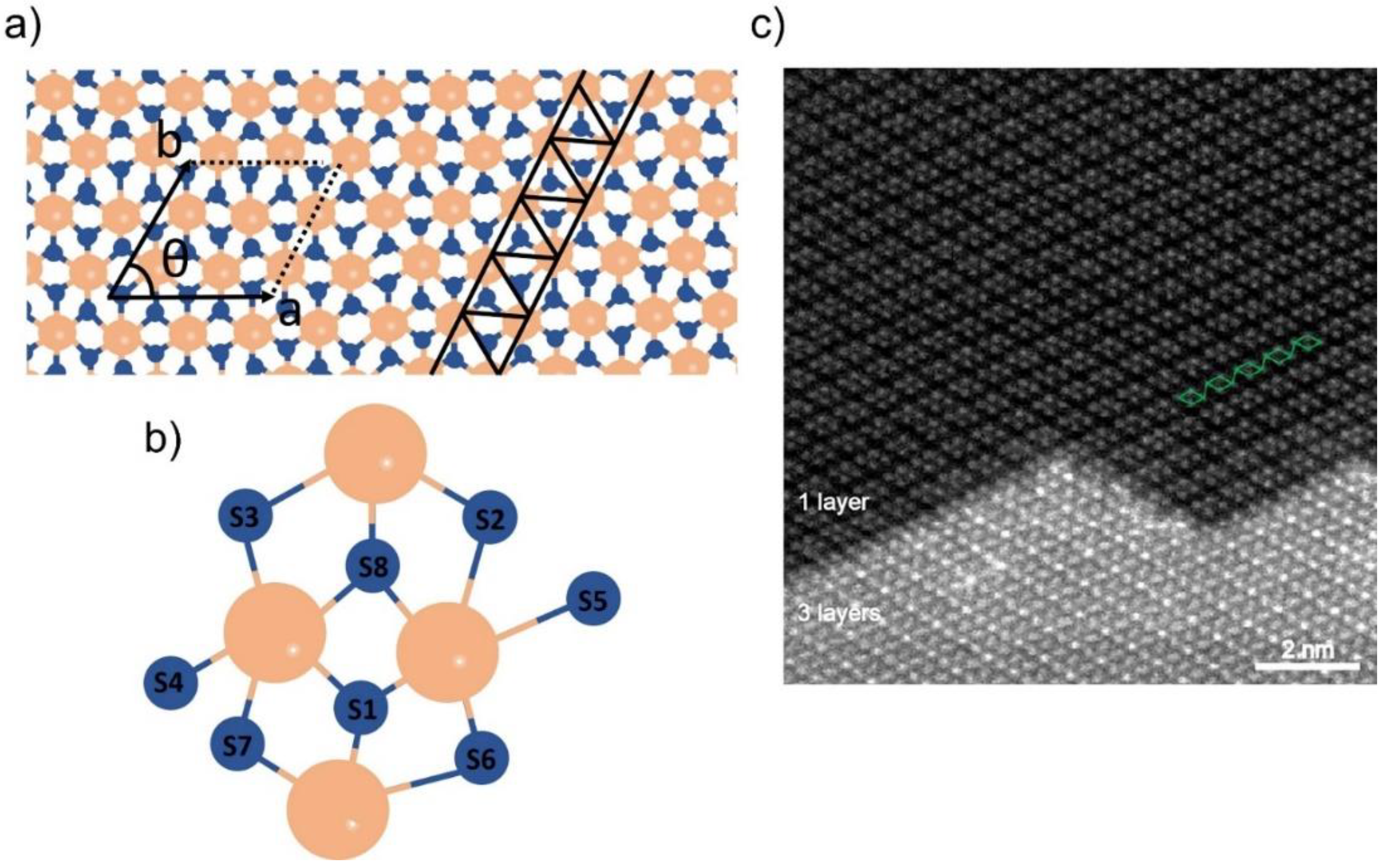


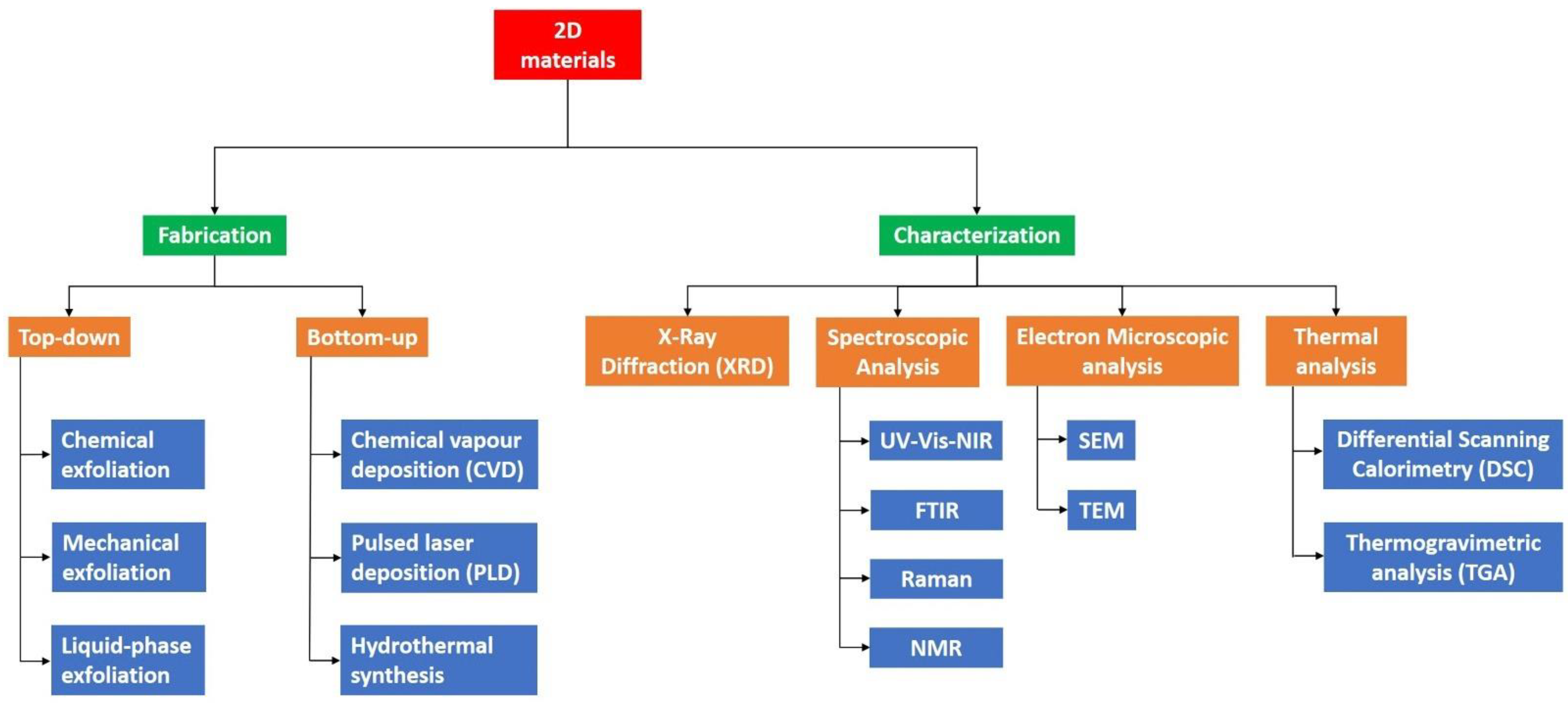
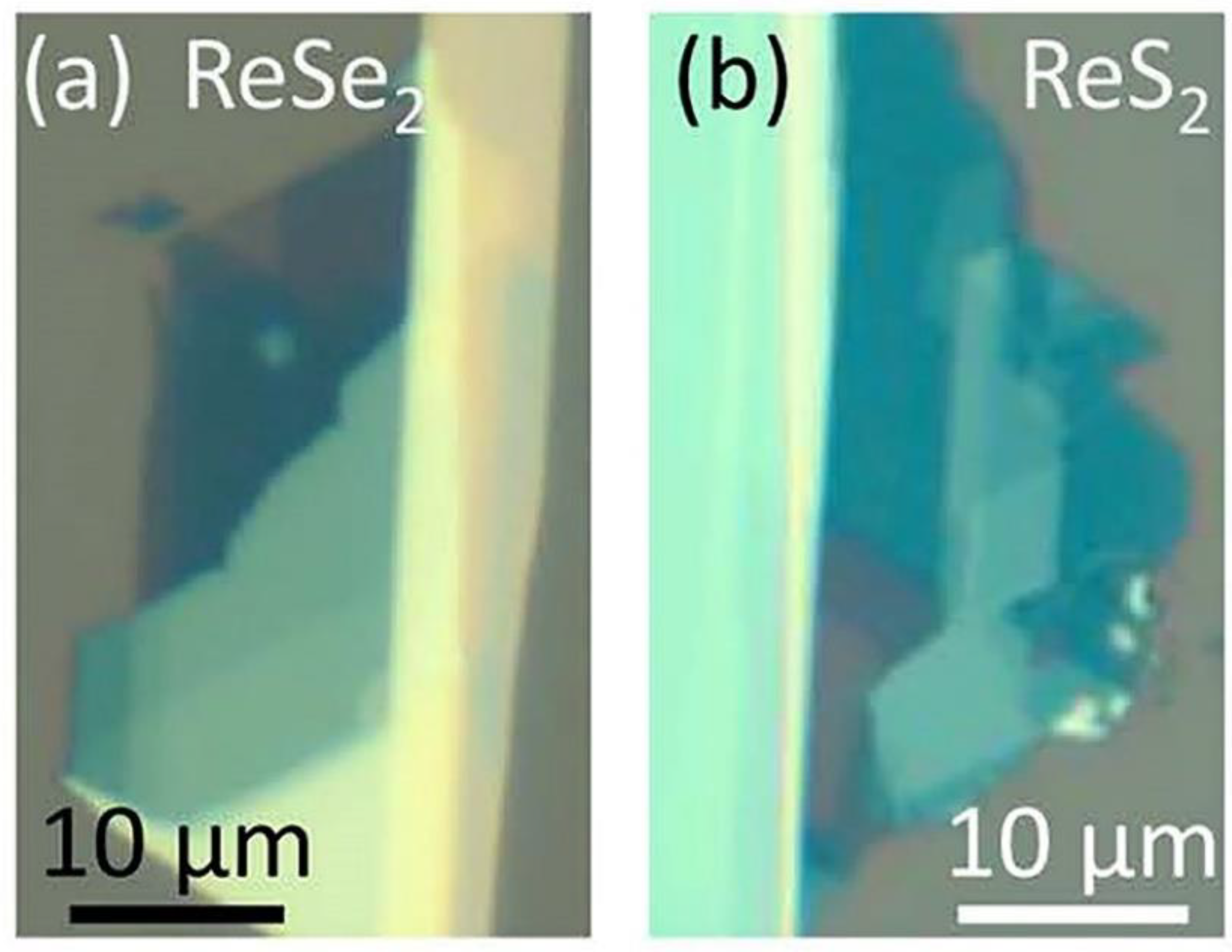

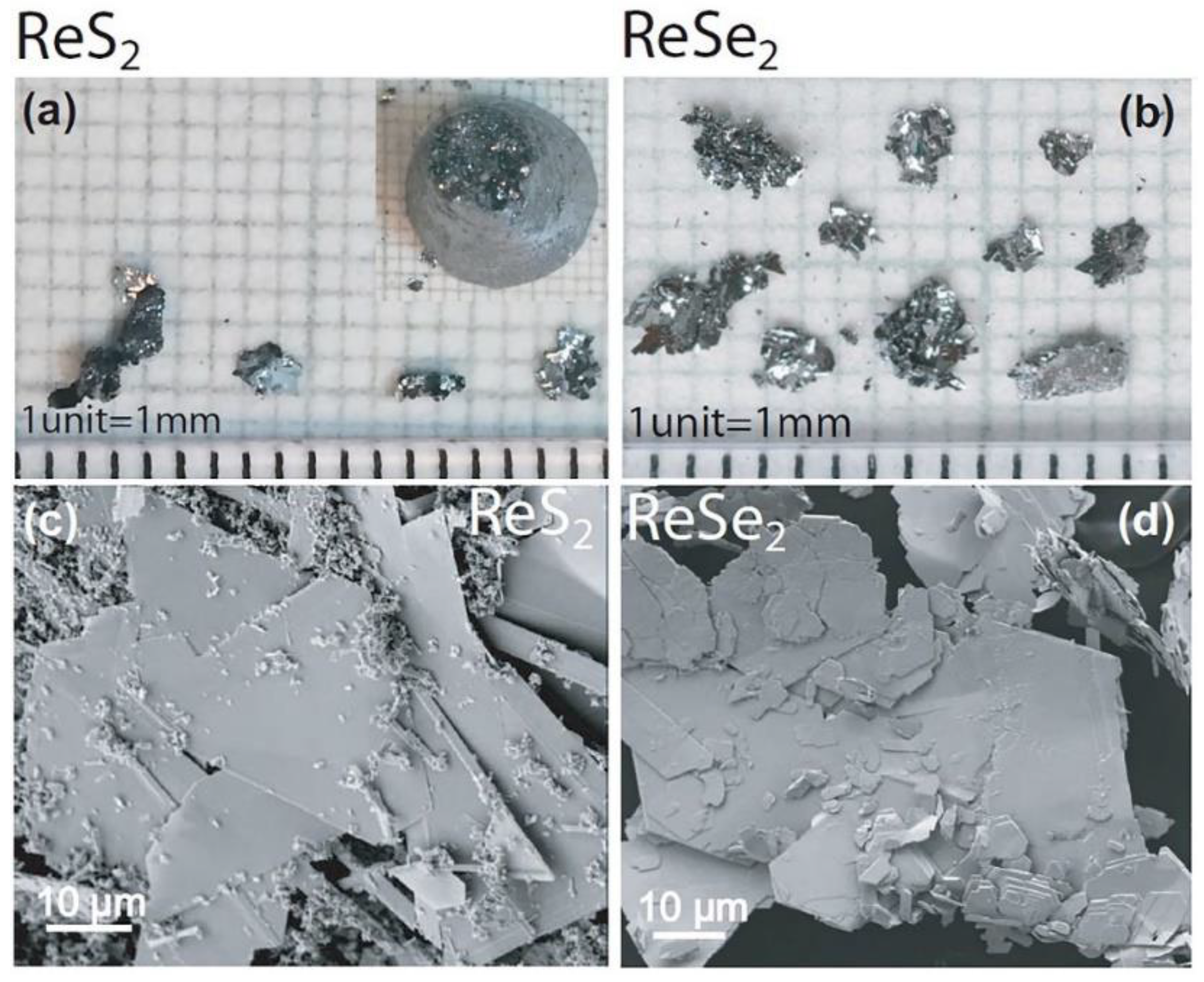
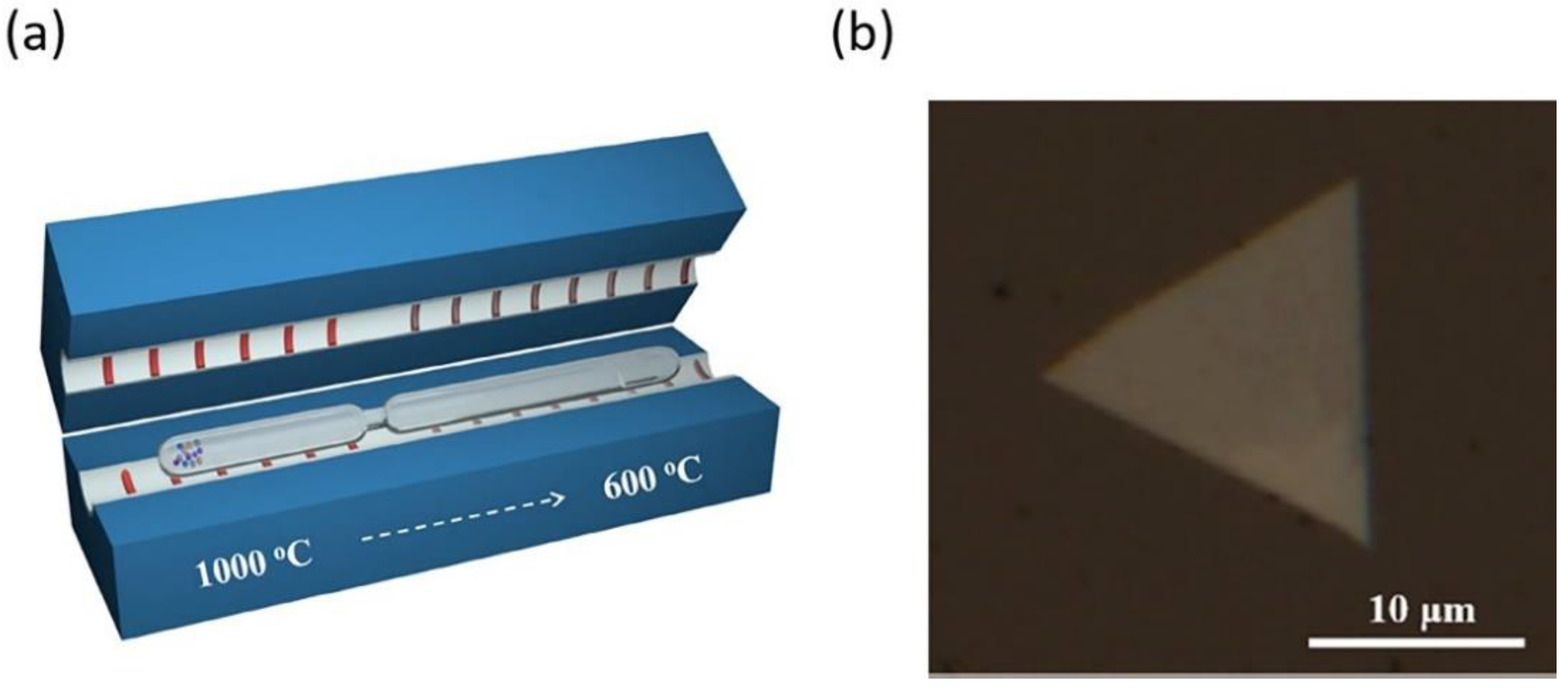
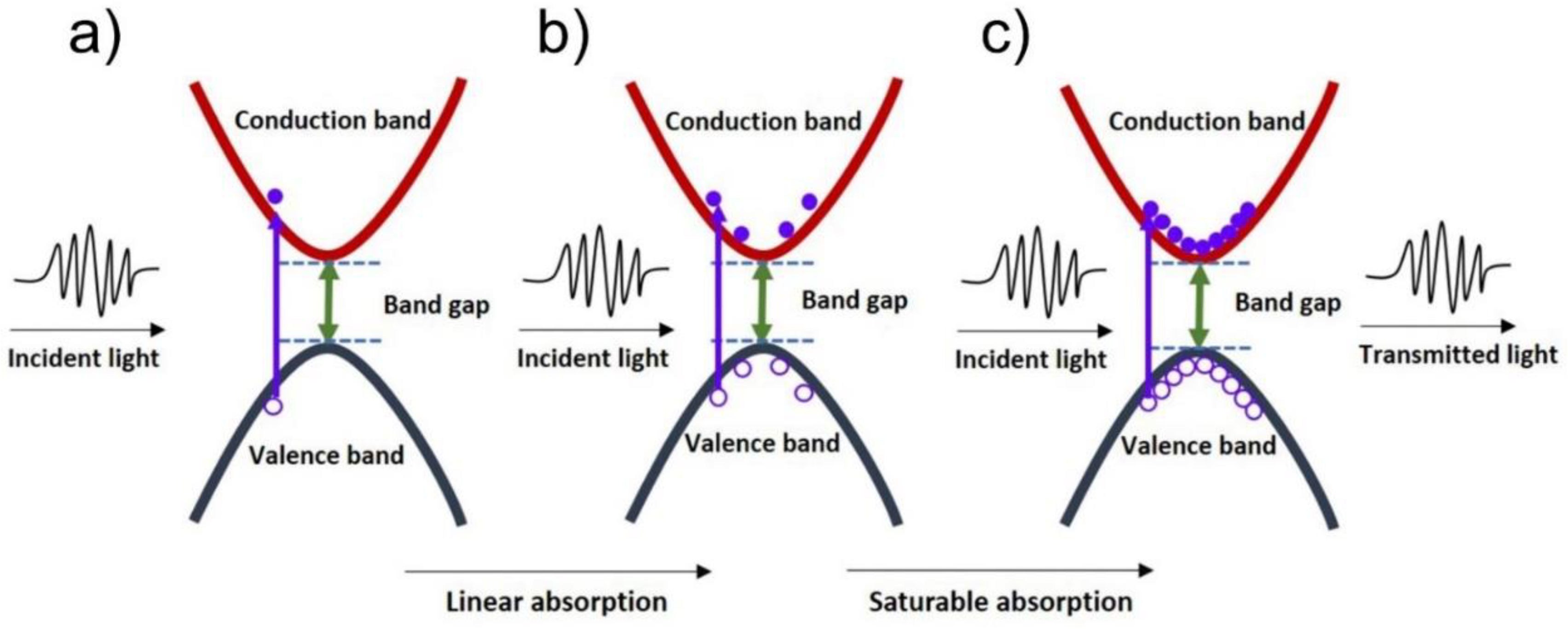
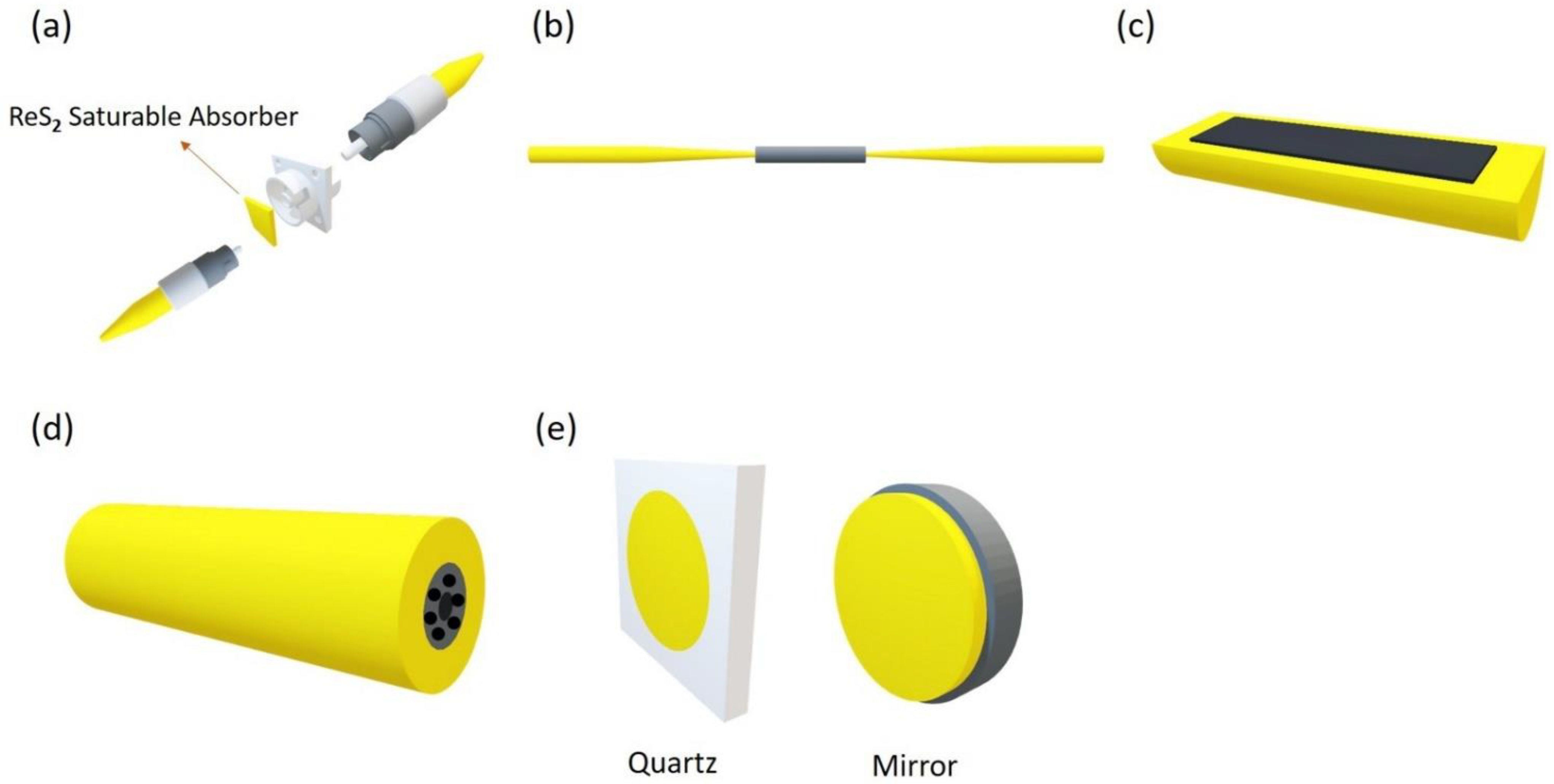

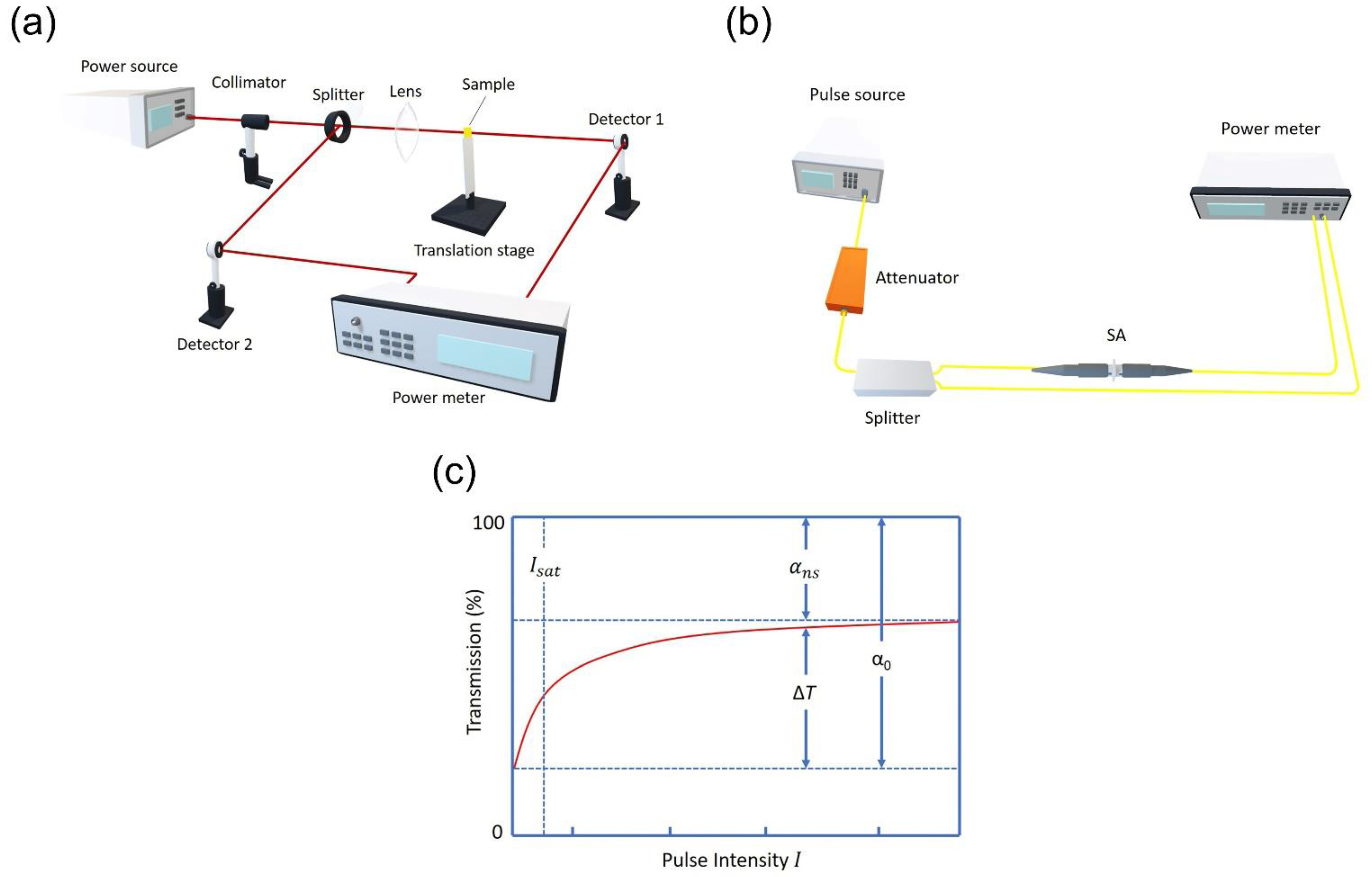

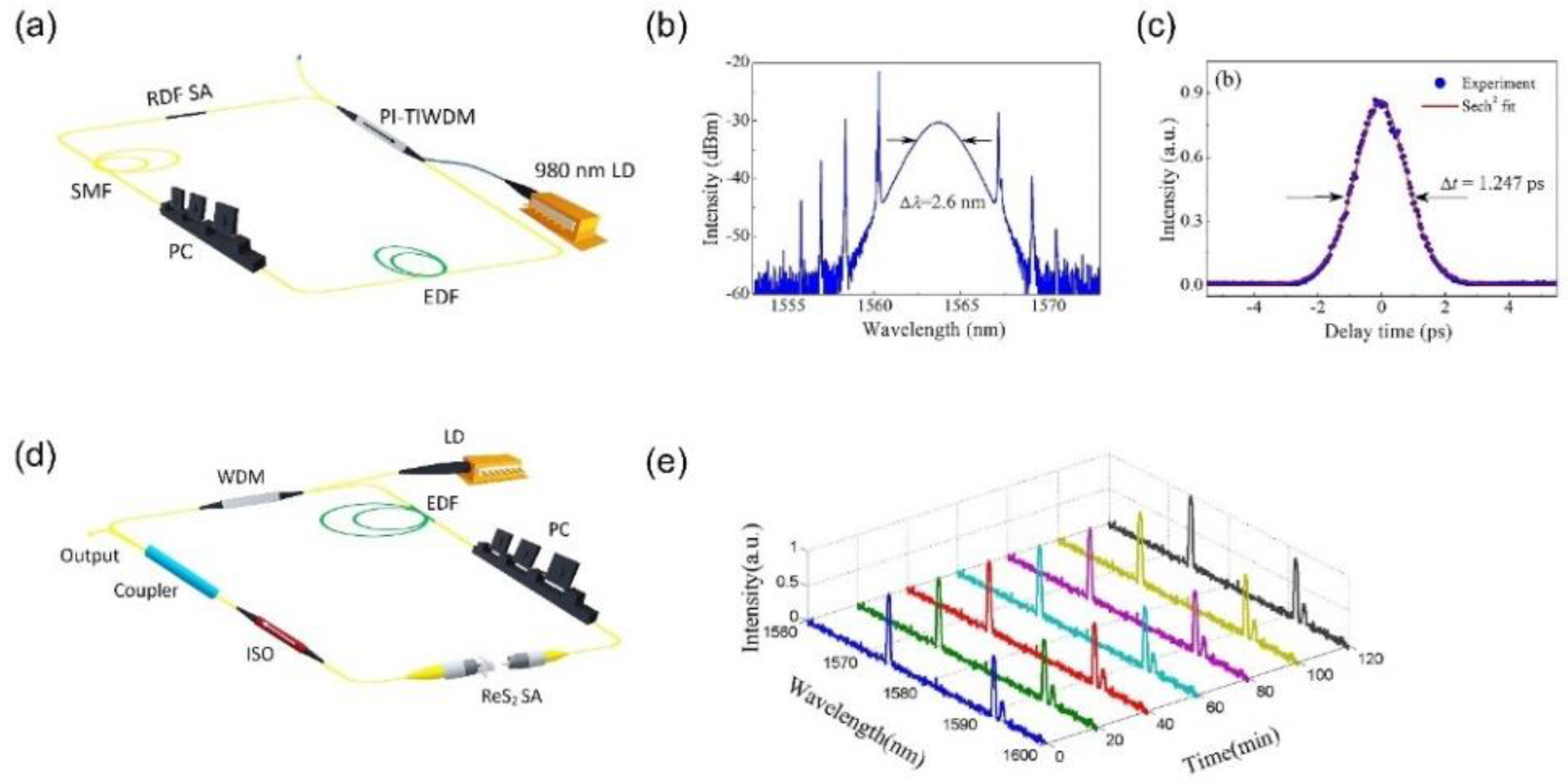

| Parameter | Symbol | Unit | Definition |
|---|---|---|---|
| Saturation intensity | The required intensity/energy/fluence to reduce absorption by 0.5 | ||
| Saturation energy | J | ||
| Saturation fluence | J | ||
| Recovery time | S | The decay time of the excitation after an exciting pulse | |
| Modulation depth (also known as saturable loss ) | ΔT 1, ΔR or | in % | Maximum possible change in optical loss [114] |
| Non-saturable loss | ( or ) | in % | Typically, unwanted part of the losses which cannot be saturated, meaning that the SA device will not reach 100% reflectivity or transmission, even for arbitrarily high pulse intensity [119] |
| Gain Medium | Fabrication Method | Integration Platform | ReS2 Thickness | Nonlinear Characterization | Laser Parameters | Ref | ||||||
|---|---|---|---|---|---|---|---|---|---|---|---|---|
| Modulation Depth [%] | Saturation Level | |||||||||||
| Yb:Fiber | ME | Fiber Ferrule | 21 nm (30 layers) | 44 | 8.4 MW/ | 1 μm (1047 nm) | 134 | 1560 | 0.00813 | 13.02 | 3.2 | [126] |
| Er:Fiber | ME | Fiber Ferrule | - | - | 150 GW/ | 1.5 μm (1532 nm) | 64 | 2100 | - | 38 | 2.48 | [61] |
| Er:Fiber | LPE | Fiber Ferrule | ∼4 nm (6 layers) | 0.12 | 74 MW/ | 1.5 μm (1557.3 nm) | 19 | 5496 | - | 62,800 | 1.2 | [63] |
| Er:Fiber | LPE | Fiber Ferrule | 5 nm (7 layers) | - | - | 1.5 μm (1550 nm) | 66.52 | 2400 | - | 18.88 | 1.25 | [64] |
| Pr:YLF Nd:YAG Tm:YAP crystals | LPE | Mirror | 4 nm (6 layers) | 3 5.2 2.9 | 58.2 μJ/ 21.5 μJ/ 2.7 μJ/ | Visible (640 nm) 1 μm (1064 nm) 2 μm (1991 nm) | 520 644 677 | 160 139 415 | 0.625 1.34 8.72 | - | 52 120 245 | [123] |
| Nd:YAG crystal | LPE | Quartz | 15 layers | 0.33 | 2.54 GW/ | Visible (946 nm) 1 μm (1064 nm) | 165 | 834 | - | 491 | 81 | [71] |
| Nd:GdLaNbO4 crystal | CVD | Sapphire | 3.5–5 nm (5–7 layers) | - | - | 1 μm (1060 nm) | 147 | 400 | 5.3 | 2120 | 312 | [127] |
| Nd:YSAG crystal | LPS | K9 glass | 6 nm | 7.4 | 207.19 MW/ | 1 μm (1060 nm) | 70 | 390 | - | - | 356 | [124] |
| Nd:YAG crystal | LPE | Sapphire | 1.4–2 nm (2–3 layers) | 2 4 | 2.17 KW/ 0.55 KW/ | 1 μm (1060 nm, 1300 nm) | 504 308.4 | 121.6 111 | 1.08 2.95 | 130 330 | 66 101 | [69] |
| Nd:YAG crystal | LPE | Sapphire | 4 nm (6 layers) | 15 | 15.6 μJ/ | 1 μm (1300 nm) | 214 | 403 | 0.9 | 420 | 78 | [70] |
| Er:YSGG crystal | LPE | Sapphire | 3.5 nm (5 layers) | 9.7 | 22.6 μJ/ | 3 μm (2800 nm) | 126 | 324 | 2.56 | 825 | 104 | [62] |
| Er:SrF2 crystal | LPE | Yttrium aluminum garnet (YAG) | 2.2 to 7.2 nm (3–10 layers) | 3.8 | - | 3 μm (2790 nm) | 49 | 508 | 22.1 | 12,100 | 580 | [125] |
| Ho,Pr:LLF crystal | LPE | Sapphire | 4 nm (6 layers) | 10.2 | 23.5 μJ/ | 3 μm (2950 nm) | 91.5 | 676 | 1.67 | 1130 | 103 | [68] |
| Gain Medium | Fabrication Method | Integration Platform | Nonlinear Characterization | Laser Parameters | Ref | ||||||
|---|---|---|---|---|---|---|---|---|---|---|---|
| Modulation Depth [%] | Saturation Level | SNR [dB] | |||||||||
| Yb:CALGO crystal | LPE | Mirror | 5.2 | 21.5 μJ/ | 1 μm (1060 nm) | 4.23 | 50.7 | 323 | 350 | 60 | [123] |
| Er:Fiber | CVD | D-shaped fiber | 1 | 27 μJ/ | 1.5 μm (1564 nm) | 2.6 | 3.43 | 1250 | - | 60 | [60] |
| Er:Fiber | CVD | Microfiber | - | - | 1.5 μm (1564.4 nm) | 0.45 | 1.896 (318.5 for HML) | 2549 | 12 | 40 | [17] |
| Er:Fiber | LPE | Fiber Ferrule | 6.9 | 27.5 μJ/ | 1.5 μm (1573.6 nm, 1591.1 nm, 1592.6 nm) | 17.5 | 13.39 | - | - | 55 | [65] |
| Er:Fiber | LPE | Fiber Ferrule | 0.12 | 74 MW/ | 1.5 μm (1558.6 nm) | 1.85 | 5.48 | 1600 | 0.4 | - | [63] |
| Er:Fiber | LPE | Double-Covered Microfiber | 0.25 | 410 mW | 1.5 μm (1563.3 nm) | 8.2 | 1.78 | 3800 | - | 68 | [67] |
| Er:Fiber | ME | D-shaped fiber | - | - | 1.5 μm (~1560 nm) | 15.4 | 14.53 | 270 | 1.08 | - | [129] |
| Er:Fiber | LPE | Microfiber | - | - | 1.5 μm (1565 nm) | 10.7 | 20 | - | 40 | 80 | [66] |
| Tm:Fiber | Hydrothermal synthesis | Side-polished fiber | 62 | 73.6 W | 2 μm (1970.65 nm) | 5.05 | 26.1 | 893 | 4.13 | 70 | [128] |
Publisher’s Note: MDPI stays neutral with regard to jurisdictional claims in published maps and institutional affiliations. |
© 2021 by the authors. Licensee MDPI, Basel, Switzerland. This article is an open access article distributed under the terms and conditions of the Creative Commons Attribution (CC BY) license (https://creativecommons.org/licenses/by/4.0/).
Share and Cite
Fadhel, M.M.; Ali, N.; Rashid, H.; Sapiee, N.M.; Hamzah, A.E.; Zan, M.S.D.; Aziz, N.A.; Arsad, N. A Review on Rhenium Disulfide: Synthesis Approaches, Optical Properties, and Applications in Pulsed Lasers. Nanomaterials 2021, 11, 2367. https://doi.org/10.3390/nano11092367
Fadhel MM, Ali N, Rashid H, Sapiee NM, Hamzah AE, Zan MSD, Aziz NA, Arsad N. A Review on Rhenium Disulfide: Synthesis Approaches, Optical Properties, and Applications in Pulsed Lasers. Nanomaterials. 2021; 11(9):2367. https://doi.org/10.3390/nano11092367
Chicago/Turabian StyleFadhel, Mahmoud Muhanad, Norazida Ali, Haroon Rashid, Nurfarhana Mohamad Sapiee, Abdulwahhab Essa Hamzah, Mohd Saiful Dzulkefly Zan, Norazreen Abd Aziz, and Norhana Arsad. 2021. "A Review on Rhenium Disulfide: Synthesis Approaches, Optical Properties, and Applications in Pulsed Lasers" Nanomaterials 11, no. 9: 2367. https://doi.org/10.3390/nano11092367
APA StyleFadhel, M. M., Ali, N., Rashid, H., Sapiee, N. M., Hamzah, A. E., Zan, M. S. D., Aziz, N. A., & Arsad, N. (2021). A Review on Rhenium Disulfide: Synthesis Approaches, Optical Properties, and Applications in Pulsed Lasers. Nanomaterials, 11(9), 2367. https://doi.org/10.3390/nano11092367








